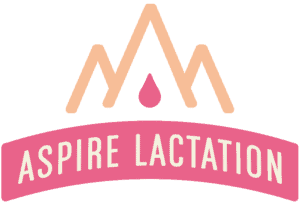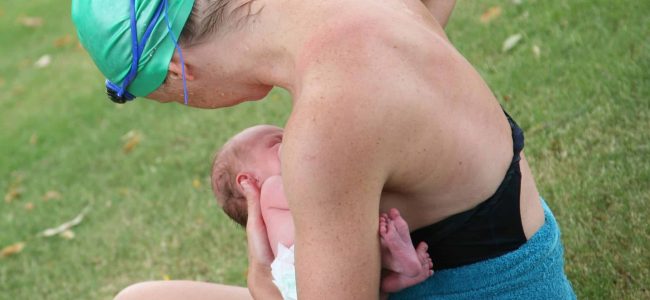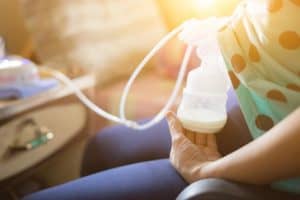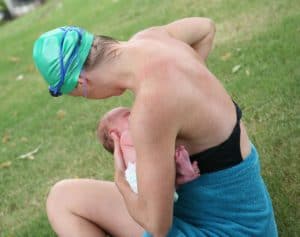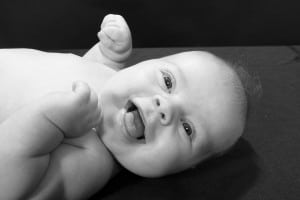So, you’ve got the all clear from your health care provider to resume exercise after baby. Can you do this and breastfeed? Sure! What about those who want to do a little more than walking to the local park with their bub, such as training for a race? A little forward planning helps, such as running after a breastfeed when breasts are softer, wearing a supportive bra – you may need to be refitted since pre-baby days – and building up your routine gradually.
When my youngest was around nine months old and still breastfeeding, I ran the Bridge to Brisbane 10km. It gave me a goal to work towards: I “Aspired” to fit into a bridesmaid dress while still breastfeeding. I realised that even though I was slower than my old pre-baby time, I was still able to run, lose weight and still keep feeding my baby. I had low milk supply and I was nervous about anything that could negatively impact it, but found it was unchanged. I just needed to make sure I kept hydrated, particularly in our hot summers. Having the time to exercise was also tricky, with two young children, so we bought a second hand treadmill for my birthday. That way, when they went down for a nap, I was able to go for a run and keep an eye on the baby monitor in case the baby woke up.
Jacinta, who was already into running and other sports prior to having her babies, says: “Basically I timed my runs straight after a morning feed, put them in the pram, ran them off to sleep and just kept running while they slept (both were 30min nappers mind you!!) Weekends were a treat, feed baby in bed, give to husband and enjoy a peaceful run with NO pram. I never found evening running successful, with likelihood of an unsettled baby, feeding times less regular and too else much to do and too tired to do it!”
“Breastfeeding burns calories, so why do I need to exercise too?”
Mothers who fully artificially feed their babies have been found to be heavier than mothers who exclusively or partially breastfed their babies at six months post birth. We already know that your amazing milk-making abilities help with weight loss. But combining breastfeeding and exercise increases weight loss, along with increased cardiovascular fitness, strength and endurance. This impacts on bone health and may reduce the chance of having osteoporosis when you get older. Not only that, but exercise can be beneficial in uplifting your mood. When combined with other treatments, exercise has been found to have a positive effect on reducing postnatal depression. On my hardest days with the children, sometimes just the act of pushing that pram up our hill and around the streets brushed out the negativity in myself (and gave the kids something new to look at other than my cranky face!). After taking the pram or baby in my carrier out for a stomp, it usually made the day more manageable.
Out of the pool, and into mum’s arms. Photo used with permission.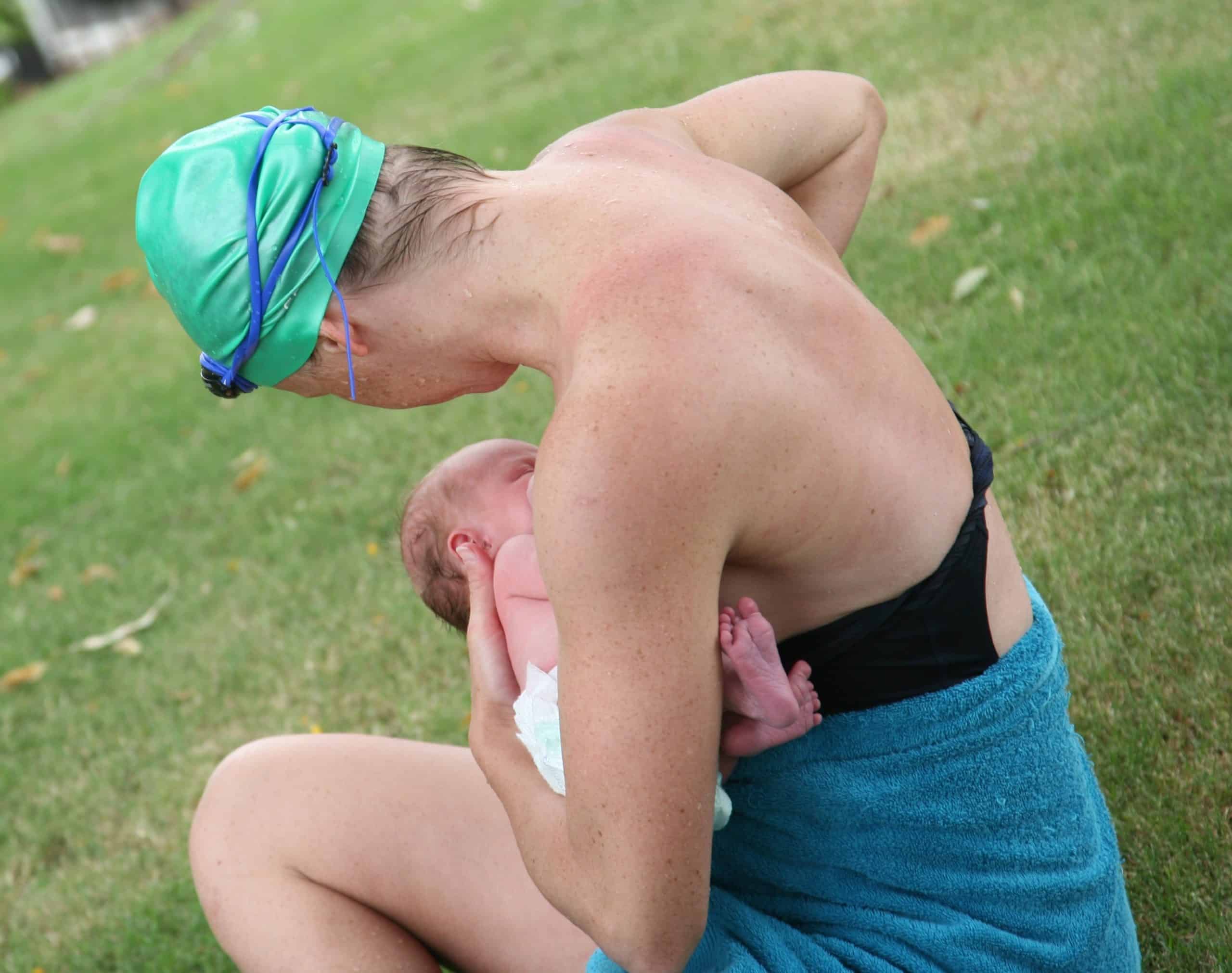
Tammy was training right up to 24 hours prior to the birth of her daughter; she returned to the pool two weeks after birth and was back in squad one week later, training five days a week. Tammy’s dedication both as a breastfeeding mother and looking after her health makes me very proud of her achievements!
For Tammy, “when I started training with a baby I had no expectations, and any opportunity to remain fit was a bonus. Looking back, the social and physical benefits of turning up to swimming squad every day has alleviated much of the stress that parenting as a new single mum might have precipitated”. Some tweaks to her swim included wearing a maternity bra under her swimmers so that she could feed during training. With time, her baby was content during a 90 min swim if she fed prior. “When Winter hit, my coach found me his son’s old Speedo coat. Lined like a wind-cheater, it reached from shoulders to knees, and had a hood. I would feed with most of my little girl lying against the coat, rather than my wet togs and bra. This prevented the usual post-feed change of her clothes that had been practical in Summer, but would have been unacceptable when the temperature dropped below 15 degrees.” When Tammy also took up running, she found that breast discomfort was eased by a doing a breastfeed prior, and that some runs, particularly in the afternoon, she had to stop and feed on the side of the road.
“I’ve heard it can make my baby fussy if I breastfeed after exercising?”
A small study in 1992 suggested that fussiness or breast refusal occurred after high intensity exercise, however the design of the study had some flaws (babies were given milk from a dropper, not breastfed; only small (1-3mL) milk samples were collected.). The fussiness in babies was thought to be from the acidic taste of milk resulting from lactic acid in breastmilk, which occurs during exercise. Further recent studies have found that although there was a rise in lactic acid up to about an hour after maximal effort exercise, there was no link to refusal of milk post this type exercise intensity. Less intense activity did not have the same rise in lactic acid levels. Although babies may fuss for a variety of reasons, it’s unlikely this would be a problem for you.
“I’m worried about my milk supply being reduced from exercise”
Although there is limited scientific information on this, 4 trials were analysed in a review. No differences in weight gains or growth were found in those babies whose mothers breastfed and exercised. If you are concerned about what might happen to your supply, start by slowly building up your exercise intensity and ensure you continue to eat and drink appropriately to keep yourself healthy.
Sarah, on the move. Photo used with permission
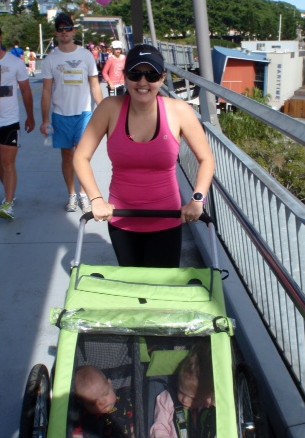
Sarah writes “I took up running a few months after having my second baby. I put on quite a bit of weight having two babies 18 months apart and was keen to get back into exercise. I was really worried about the potential impact of such strenuous exercise on my milk supply as I didn’t have oodles to start with. I am happy to say I didn’t notice any reduction in my supply at all. I am now training for a 10km run and still happily breastfeeding my son with no problems. I waited until [he] was 8 weeks before I started properly exercising so his feeding was a bit more regular and there were less interruptions. I try and feed before and after my workouts. Manoeuvring a sports crop top can be challenging but you just make it work. I had to feed him once mid way through a gym session. Lucky he is a quick feeder so it really wasn’t a problem.”
Even if you’re not planning on training for an event or just wanted to get fit and healthy, there are plenty of ways you can incorporate exercising and breastfeeding. You could join a gym with childminding facilities, so that you can feed your baby if needed during a workout. Local councils such as the Brisbane City Council often run free exercise classes in the park for mums and bubs, which I found a great way to get out and active. Personal trainers such as Belinda Dever’s Mums-ercise run classes especially for mums; she also conducts some of the free BCC classes on the south side of Brisbane. I’ve recently heard about a baby-wearing exercise class running in some areas of Australia! Why not invest in a sturdy and comfortable pram and take your crew (including your fur-babies) for some fresh air? Maybe even swing by a coffee shop and enjoy a sneaky quiet coffee before the baby is old enough to start nagging for babycinos and biscuits!
Aspire to achieve….like these amazing mums have.
If you need support with your breastfeeding, why not book a consult with me? Visit my Services page for more information on my pricing and consult options.
Naomi Drew, IBCLC
References
- Daley, A.J., Thomas, A., Cooper, H., Fitzpatrick, H., McDonald, C., Moore, H., Rooney, R.& Deeks, J.J. (2012) Maternal Exercise and Growth in Breastfed Infants: A Meta-analysis of Randomized Controlled Trials Pediatrics, 130, 108-114
- Lovelady, C. (2011) Symposium on ‘Nutrition: getting the balance right in 2010’ Session 1: Balancing intake and output: food v. exercise Balancing exercise and food intake with lactation to promote post-partum weight loss. Proceedings of the Nutrition Society, 70, 181–184
- Mortensen, K., & Kam, R. (2012) Exercise and Breastfeeding. Breastfeeding Review, 20 (3), 39-42
- Wallace, J.P., Ingar, G. & Erthshausen, K. (1992) Infant Acceptance of Postexercise Breast Milk, Pediatrics, 89, 1245-1247
- Wright, K. S., Quinn, T.J. & Carey G.B. (2002) Infant Acceptance of Breast Milk After Maternal Exercise. Pediatrics, 109, 585-589
